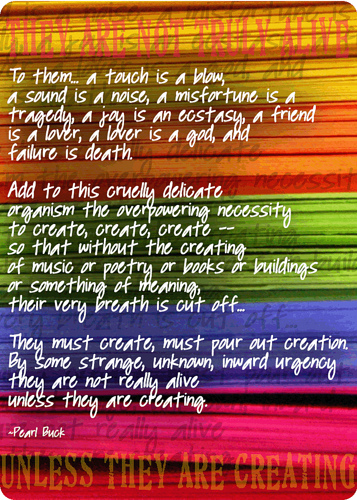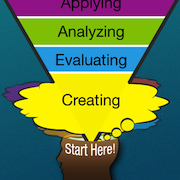Encouraging Teachers to Teach Creativity
Encouraging Teachers to Teach Creativity
Posted by Margaret Haviland on Jun 5, 2012
 A few weeks ago fellow Voices blogger Shelley Wright wrote a provocative blog on flipping Bloom’s Taxonomy and beginning the learning experience with Creativity. As the person most directly responsible for our school’s professional development I have been wondering what professional development looks like when you turn Bloom’s on its head.
A few weeks ago fellow Voices blogger Shelley Wright wrote a provocative blog on flipping Bloom’s Taxonomy and beginning the learning experience with Creativity. As the person most directly responsible for our school’s professional development I have been wondering what professional development looks like when you turn Bloom’s on its head.
Teachers young and old are comfortable with the old model and path. Even if they have never heard of Bloom’s Taxonomy (it happens in independent schools where some young teachers have never taken an education course), teachers are inherently comfortable with the approach the taxonomy lays out. Remembering and Understanding are sooo easy to assess—give a quiz; find out what you student doesn’t know. Applying and Analyzing are practiced at each level of a teacher’s own education and eventually applied as an educator—analyzing new texts, applying new techniques.
Ongoing education for teachers in all of Bloom’s Taxonomy except for Creativity is relatively straightforward. If you are an Asian History teacher, you attend an institute at some wonderful Center for Asian Studies; if you are a Math teacher you attend a workshop on technology in the math classroom or a week long session on delivering your school’s math program. If you want your faculty to rethink how they teach to multiple intelligences you focus your in-service days for the year on this topic.
Encouraging teachers to teach creativity requires a different approach.
Why teachers who create do Creativity so well
While it’s not a part of their job description, nor was it a requirement for their hiring, every art teacher at my school is a practicing artist. Each pursues his or her own distinctive expressive media—photography, pottery, mixed media, oil paints, lithograph prints. Routinely, they bring their own thought process and fresh insights into the classroom with their students. They model creativity. Students learn in partnership about asking questions, choosing a path through a project, taking chances from seeing their teachers personal successes and failures (sharing failures is key!)
Art teachers don’t have a monopoly on sharing their own creativity. I have an English colleague who is a published author and shares with her classes her ongoing writing process from stumbling blocks to breakthroughs. A Math colleague has started his own school in Ghana, and his math classes benefit from his sharing with his students the innovative resolutions he finds to problems with opening and then operating a successful school.
I argue that part of the work of educational leaders from folks with titles like mine, to first adopters like our Middle School History teacher, is to encourage and nurture Creativity within our faculty. Not every English teacher needs to be a published author, but every English teacher should be transparently sharing with their students their own creative efforts whether it’s rethinking an approach to teaching, solving a problem with the class or their engagement with an issue. For instance, I have another colleague who has a number of our students working with her to crochet roses (the symbol associated with Cystic Fibrosis) as an ongoing fund raiser.
In working with faculty on setting professional growth goals, instructional leaders should put a focus on creative engagement, creative expression, creative rethinking of an old lesson at the core of the process.
Teaching Creativity is messy
I have a Chemistry colleague who didn’t answer a student’s question. It had to do with acid and what happens when human skin is splashed with acid. Instead, he asked his students to find the answer. One week later, after a lot of spoiled beef, great questions, and a very stinky lab, the students had pursued ingenious approaches to answering that original question. (One of the follow up questions was why stomach acid doesn’t destroy the lining of the stomach.)
 Did they fully answer every question? No. Stepping out of the standard Chemistry curriculum means you might not end up with a neat and tidy final solution. The assessment for this week’s worth of work couldn’t possibly be a traditional test. Even the standard lab report failed to capture the types of learning going on in that lab. Written self reflections began to get at students’ sense of themselves as agents looking for imaginative ways of finding solutions to each step of their unplanned and unfolding process.
Did they fully answer every question? No. Stepping out of the standard Chemistry curriculum means you might not end up with a neat and tidy final solution. The assessment for this week’s worth of work couldn’t possibly be a traditional test. Even the standard lab report failed to capture the types of learning going on in that lab. Written self reflections began to get at students’ sense of themselves as agents looking for imaginative ways of finding solutions to each step of their unplanned and unfolding process.
For the plunge into original thinking described above, we need to help colleagues take one unit each marking period, rethink the outcome, rethink the assessment(s) and then develop the path for students. A World Languages teacher might be encouraged to move from a traditional grammar/vocabulary quiz in a level two language class to one focusing on language production. Given the new outcome, the unit assessment might include students interacting with target-language peers via the internet. What creative resourceful suggestions might students generate for the gaps in their vocabulary? What happens when young people speak with other young people about a topic of interest?
Maybe all the desired vocabulary will be covered, maybe it won’t. Is it more important that the prescribed vocabulary is covered or that students experience the excitement of using the language and therefore the utility of learning more vocabulary? Do the student’s own solutions for overcoming language barriers serve them well? My own answers to these questions all land in favor of the messy side. But how do you assess this sort of learning?
Assessing efforts to teach Creativity
Teaching Creativity includes formative assessment and carefully constructed rubrics. The best means for increasing faculty comfort with the lack of linearity in encouraging student inventiveness is to model it first, nurture every step, require supported change, and give faculty tools for assessing. In the realm of creativity, formative assessment always trumps traditional summative assessment. The meat rotted, the pot blew up in the kiln, the computer programmers ran out of time, the cake reproduction of St. Basil’s Cathedral fell apart on the way to class, the team’s wiki-page editor broke her leg, the local paper didn’t print the letter to the editor on stream restoration. Failure is all too real when it comes to the “final project.”
Rather than a final grade, students should be getting regular feedback, constructive criticism, probing (as opposed to leading) questions from their teacher and their peers. This feedback needs to measure specific aspects of the learning as laid out in the unit or topic goals. Rubrics geared towards creativity need to be clear and based on learning objectives. These objectives will be process focused: how did students choose a substitute for human flesh, what strategies did level two language student use for communicating with native speakers, what choices compromises were made in translating St. Basil’s architecture into cake, where did you find an expert on stream restoration?
Formative rubrics should be the focus in teaching creativity with summative assessment focused on the overall process as much as the product. Rubric writing with creativity as the learning goal is an area for fruitful professional learning whether it’s an all day in-service, an ongoing project with a colleague, or a workshop led by someone who feels successful. I think peers are often the best teachers.
We will get what we assess
If we want students to know 99 random facts we create a test such as the SAT II subject test. If we want students to learn to write an analytical essay, we assign an essay, then grade it for form, style, grammar, content, and correct bibliography. If we want students to think and act creatively than the assessments we create for them must measure creativity.
Ingenuity, inventiveness, originality are non-linear, iterative, and prone to failure. Failure is great! Failure here is different from failing to demonstrate understanding of graphing logarithms in a pre-calc test; this kind of test measures grasp of the content and application. Our assessments for creativity need to reward failure within the creative process.
In modeling our own creative process we powerfully model for our students the rewards of approaching their lives with joyful wonder, the resilience to fail, the agency to seek their own solutions. The increased creativity in faculty and in students becomes the measure of successful professional development within our schools.
Image: Creative Commons
Subscribe to the Voices
Get the latest news and updates from the Voices from the Learning Revolution. Subscribe to our newsletter.
About the author
Views: 37
Tags:
Welcome to
THE VISUAL TEACHING NETWORK
About
© 2025 Created by Timothy Gangwer.
Powered by
![]()
You need to be a member of THE VISUAL TEACHING NETWORK to add comments!
Join THE VISUAL TEACHING NETWORK